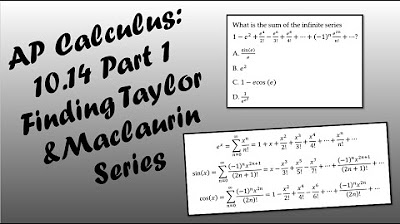Visualizing Taylor series approximations | Series | AP Calculus BC | Khan Academy
TLDRThis video script discusses the practical application of polynomial approximations using the example of approximating the sine function through Maclaurin or Taylor series expansion. The demonstration, powered by WolframAlpha, illustrates how adding more terms improves the accuracy of the approximation, showing that higher-order polynomial terms hug the sine curve more closely, particularly for smaller values of x. The video encourages exploration of various functions and their series expansions on WolframAlpha for a deeper understanding of mathematical approximations.
Takeaways
- 📊 The video discusses the use of polynomials to approximate functions, specifically focusing on the demonstration of this concept in practice.
- 🌐 The presenter uses WolframAlpha, a powerful online mathematical tool, to illustrate the approximation process.
- 🔍 The concept of Maclaurin series expansion, which is a Taylor series expansion at x=0, is introduced to approximate the sine function.
- 📈 The approximation becomes more accurate as more terms are added to the series, with the polynomial hugging the sine curve more closely.
- 📊 The visual representation shows the improvement in the approximation with the addition of each term, indicated by the number of dots on the graph.
- 🔢 The script explains the mathematical concept of factorials and how they are used in the calculation of the series expansion.
- 📌 The presenter emphasizes the practicality of WolframAlpha for quick calculations and visual representations of mathematical concepts.
- 📈 The video script demonstrates the progression from a rough approximation with a single term to a more refined approximation with multiple terms.
- 🤔 The presenter encourages viewers to experiment with different functions and terms on WolframAlpha to understand the nuances of polynomial approximation.
- 🌟 The idea that an infinite number of terms in the series would result in a perfect hug to the sine curve is introduced, highlighting the power of series expansions.
- 📚 The video serves as an educational resource for understanding the practical application of polynomial approximations and the utility of mathematical tools like WolframAlpha.
Q & A
What is the main topic discussed in the video?
-The main topic discussed in the video is the use of polynomials to approximate functions, specifically demonstrating the approximation of the sine function using Maclaurin series expansion or Taylor series expansion.
Which website is used to illustrate the approximation of functions?
-WolframAlpha is the website used to illustrate the approximation of functions in the video.
What does the video demonstrate about the relationship between the number of terms in a series expansion and the accuracy of the approximation?
-The video demonstrates that adding more terms to the series expansion improves the accuracy of the approximation, causing it to hug the sine curve more closely.
What is the significance of the dots in the graphed approximations shown in the video?
-The dots in the graphed approximations indicate the order of the terms used in the series expansion. The more dots, the more terms are included in the approximation.
How does the first term of the sine function approximation (p of x equals x) relate to the sine curve?
-The first term of the sine function approximation (p of x equals x) provides a rough approximation that hugs the sine curve decently, especially for smaller values of x, but starts to veer away as x increases.
What happens when the second term of the series expansion (x minus x to the third over 6) is added to the approximation?
-Adding the second term of the series expansion causes the approximation to hug the sine curve earlier and to keep hugging it a little bit later, improving the accuracy of the approximation for a wider range of x values.
What is the role of higher-degree terms in the series expansion?
-Higher-degree terms in the series expansion become more significant for larger values of x, where the numerator can start to overpower the denominator, thus refining the approximation further away from the origin.
What would be the result if an infinite number of terms were used in the series expansion?
-If an infinite number of terms were used in the series expansion,理论上, the approximation would perfectly hug the sine curve out to infinity, providing an exact representation of the function.
What functions can be explored on WolframAlpha to understand their series expansions?
-On WolframAlpha, one can explore the series expansions for functions such as sine of x, cosine of x, and e to the x, among others, by typing 'Taylor expansion at 0' followed by the function's name.
How can one experiment with different functions and their approximations on WolframAlpha?
-One can experiment with different functions and their approximations on WolframAlpha by typing in 'Taylor expansion at 0' or 'Maclaurin series' followed by the name of the function, and then adjusting the number of terms to see how the approximation changes.
Outlines
📊 Demonstrating Polynomial Approximations with WolframAlpha
This paragraph discusses the use of polynomials to approximate functions, specifically focusing on the sine function. The speaker uses WolframAlpha, a powerful mathematical tool, to visually demonstrate how increasing the number of terms in a polynomial approximation improves its fit to the sine curve. The explanation includes the concept of Maclaurin and Taylor series expansions at x equals zero and how adding higher-order terms with larger denominators enhances the approximation for small x values. The speaker also shares an anecdote about meeting Steven Wolfram and encourages viewers to explore various functions on WolframAlpha.
🔍 Exploring the Impact of Additional Terms in Polynomial Approximations
The second paragraph delves deeper into the effect of adding more terms to polynomial approximations. It explains how the later terms, with higher powers of x and larger denominators, become significant as the value of x increases. The speaker illustrates this by showing how the addition of each term improves the approximation, especially for larger x values. The paragraph concludes with a suggestion for viewers to experiment with different functions and terms on WolframAlpha to gain a better understanding of how polynomial approximations work and to visualize the sin curve's approximation approaching perfection with an infinite number of terms.
Mindmap
Keywords
💡Polynomials
💡Approximation
💡WolframAlpha
💡Maclaurin Series Expansion
💡Taylor Series Expansion
💡Sine Function
💡Graphing
💡Factorials
💡Degree of a Polynomial
💡Curve Fitting
💡Infinite Series
Highlights
The video demonstrates the practical application of polynomials in approximating functions, specifically focusing on the sine function.
WolframAlpha is introduced as a powerful tool for performing complex mathematical calculations and visualizing approximations.
The concept of Maclaurin series expansion, also known as Taylor series expansion, is explained as a method to approximate functions like sine.
The more terms added to the series expansion, the closer the approximation aligns with the actual function's curve.
A visual representation of the sine function and its approximations is provided, with different colors indicating various degrees of the polynomial.
The first-degree term approximation (p of x equals x) is shown to provide a rough but workable approximation of the sine function.
The addition of higher-order terms improves the approximation, with the third-degree term allowing the polynomial to hug the sine curve more accurately.
The fifth-degree polynomial approximation is shown to extend the range over which the approximation closely follows the sine function.
The seventh-degree polynomial further refines the approximation, hugging the sine curve for a broader range of x values.
The inclusion of the ninth-degree term in the approximation significantly extends the range of accurate fitting, especially for larger x values.
The video emphasizes the diminishing impact of higher-degree terms for small x values due to the dominance of the denominator over the numerator.
The concept of infinite terms in a series expansion is discussed, suggesting that it could perfectly approximate the sine function.
The video encourages viewers to explore different functions and series expansions on WolframAlpha to understand the varying degrees of approximation.
The transcript provides a comprehensive overview of using polynomial approximations to understand and visualize mathematical functions, emphasizing the utility of tools like WolframAlpha.
The video serves as an educational resource for those interested in the practical application of mathematical theories and the use of technology in mathematical visualization.
Transcripts
Browse More Related Video

Taylor & Maclaurin polynomials intro (part 1) | Series | AP Calculus BC | Khan Academy

AP Calculus BC Lesson 10.14 Part 1

Visualizing Taylor polynomial approximations | AP Calculus BC | Khan Academy

Taylor Polynomials Day 1

Avon High School - AP Calculus BC - Topic 10.11 - Example 2

2011 Calculus BC free response #6a | AP Calculus BC | Khan Academy
5.0 / 5 (0 votes)
Thanks for rating: